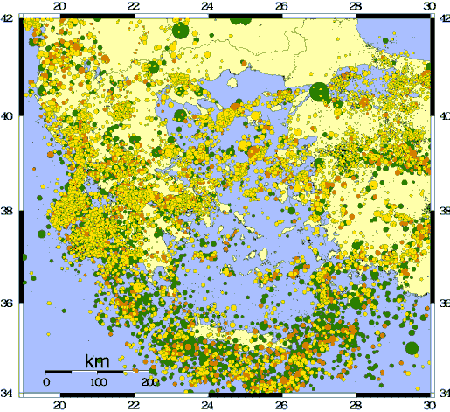
The
depth of the earthquakes in km: orange: 0-40, yellow: 40-80, green:
80-150.
|
Geology |
| Greece lies in the seismic zone, where the African tectonic plate is pushed under the Eurasian. The majority of the earthquakes that strike Greece, occur along the so-called "Hellenic Arc", which stretches out from Yugoslavia over The Ionian Islands, the western Peloponnese, Crete and The Dodecanese to south-western Turkey. |
|
|
|
|
The
depth of the earthquakes in km: orange: 0-40, yellow: 40-80, green:
80-150. |
|
| The circles indicate the size of the earthquakes. | |
|
|
| The
earthquakes occur in a relatively low depth, 40 - 80 km, but around Crete
they have a tendency to being deeper. Luckily Greece is rarely struck by
very heavy quakes - most of them have a magnitude of 4 - 6 on the Richter
scale.
|
| The
earthquakes at Crete mostly have their epicentres in the sea south of the
island.
Crete
has, however, been hit by violent earthquakes in the past. Beneath you
find a list of earthquakes mentioned in different sources:
|
| 368 BC |
The earthquake is estimated to have been 7,7 on the Richter scale. According to the Roman historian Pliny, 60 cities were destroyed. | |||
| 267 BC | Crete was hit by an earthquake of 7,0. | |||
| 255 BC | An earthquake of 6,8 hit the island. | |||
| 55 AD | An earthquake of 7,2 destroyed many cities and resulted in lethal epidemics. | |||
| 66 AD
|
An earthquake of 7,0 hit Crete. Destruction of the temple of Asklepios in Lendas on the Southern coast. Sources mention that an island temporarily appeared between Santorini and Crete. | |||
| 251 AD | An earthquake of 7,5 destroyed parts of Knossos and Phaistos. | |||
| 365 AD
|
On July 21, a gigant earthquake of 9,2 caused a tsounami that hit all the coastal areas of the Mediterranean with major devastation. At the same time, Western Crete was lifted approx. 9 metres, so the flourishing Roman habour in Phalasarna was cut off from the sea and was placed about 100 m inland. The Roman soldier and historian Ammianus Marcellinus (325-391) has in his work Res gestae described the phenomenon: The sea retreated and the water disappeared to such an extent that the seabed appeared ... Many ships stranded and people walked around and collected fish and mussels. But shortly afterwards a huge wave came rushing and crushed buildings and everything that it met on its way. Some large ships were swept up on the rooftops, and others were moved up to 2 miles inland. | |||
| 439 AD | An earthquake of 7,6 caused major destructions in Southern Crete. | |||
| 796 AD
|
Theophanis mentions in his Chronographia a violent earthquake on April 7. Especially Gortyna was hit, and the basilica collapsed partly. The earthquake was also felt in Alexandria in Egypt, where the Pharos of Alexandria was damaged. | |||
| 1246 AD | An earthquake of 6,8 hit Chania, and parts of the citywall were damaged. | |||
| 1306 AD | An earthquake of 6,5 hit Iraklion. | |||
| 1494 AD
|
Earthquakes up to 7,2 in Iraklion. The tremors continued for one month. The traveler Pietro Casola mentions, that the first shake happened at 4 p.m. The monastery of Agios Franciscos and a lot of bell towers suffered severe demolitions. During the following days there came many reports about damages from all around the island. | |||
| 1508 AD
|
On May 29 a severe earthquake of 7,2 hit Sitia and Ierapetra, which was completely destroyed. Later a new urban area was constructed close to the fortress. Iraklion was also hit violently. There exits a desciption of the quake written by the Venetian Duke Gieronymo Donato in a letter to his friend Pietro Contarino. | |||
| 1595 AD | An earthquake of 6,8 hit Crete on November 26. It caused large destuctions – especially in Chania and Iraklion. | |||
| 1612 AD |
On November 8 Iraklion was struck by an earthquake of 7,0. The shakes were felt in many places in the Mediterranean. | |||
| 1655 AD |
In January an earthquake of 6,7 hit Iraklion, and several houses collapsed. The earthquake was also felt on the island of Zakynthos. | |||
| 1681 AD | For three days earthquakes up to 7,0 on the Richter scale repeatedly ravaged the area around Iraklion. | |||
| 1780 AD |
In October a severe earthquake of 7,0 followed by smaller ones hit the area of Ierapetra. The fortress collapsed, and thirteen villages were destroyed. | |||
| 1805 AD |
Early in the morning of July 3 four violent earthquakes of up to 7,2 hit Chania within eight minuts. There were large damages in Chania and Rethymno. | |||
| 1810 AD
|
On February 16 an earthquake of 7,8 hit Iraklion and damaged many houses, sources mention one third of the houses. Several thousands people died due to the the strike. The monastery of Agion Asomaton in the Amari valley was destroyed. | |||
|
|
||||